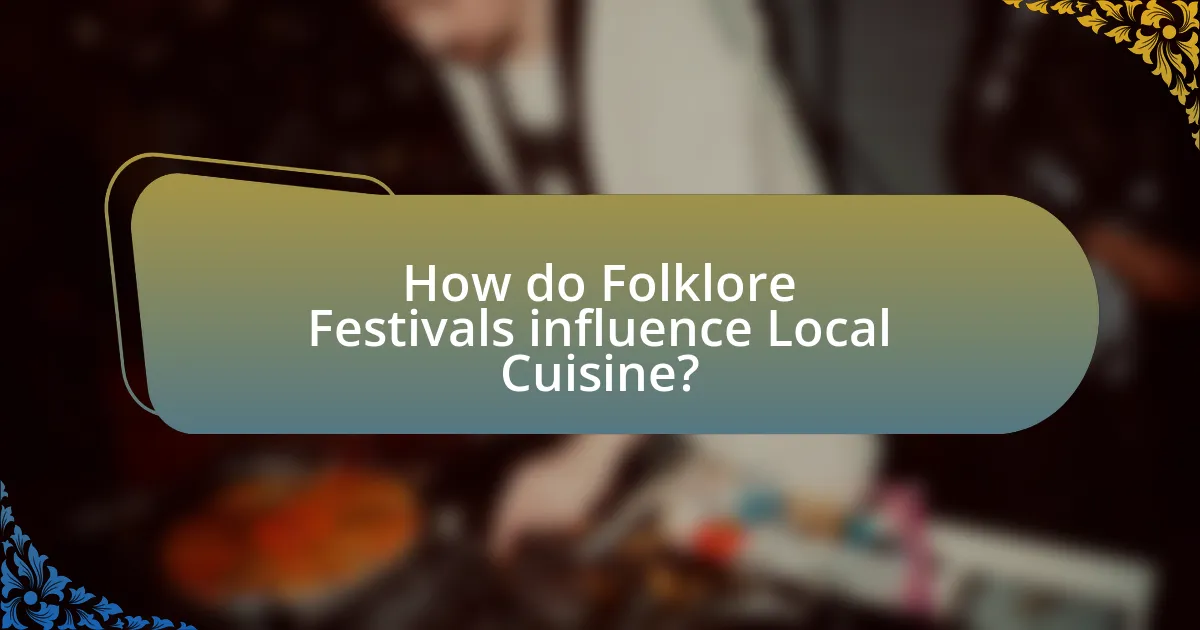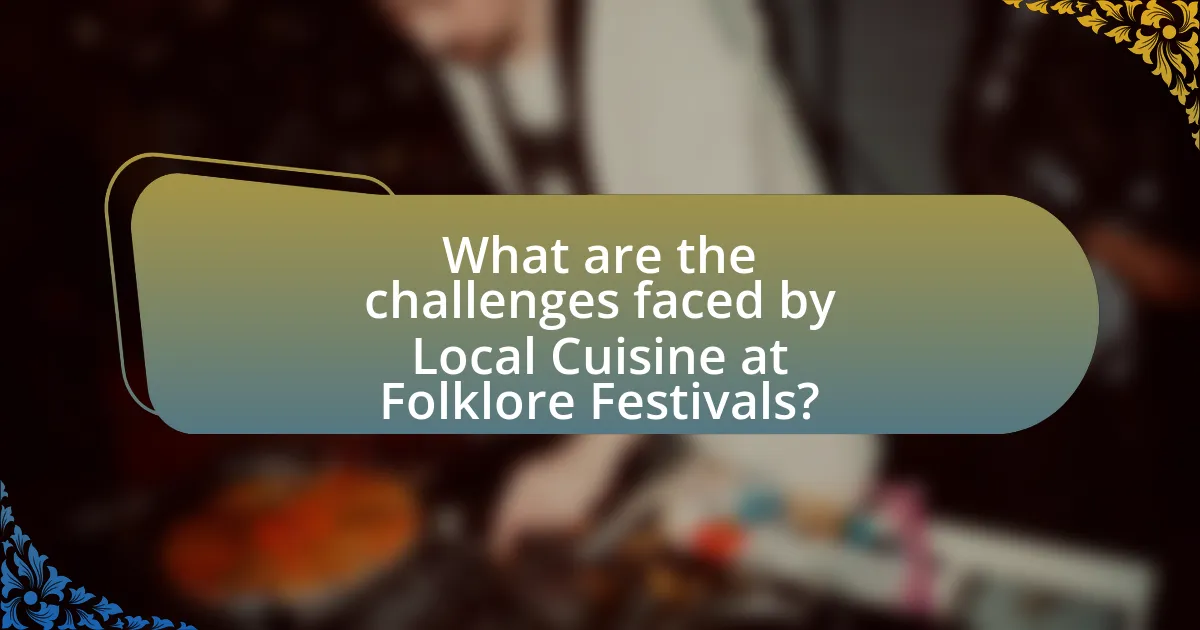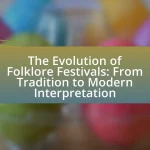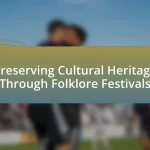Folklore festivals are cultural events that celebrate and preserve the traditions, customs, and artistic expressions of communities worldwide. These festivals feature music, dance, storytelling, crafts, and local cuisine, highlighting the unique heritage of participants. The article explores how folklore festivals vary across cultures, the common themes they share, and their significance in fostering community engagement and preserving cultural heritage. It also examines the influence of local traditions on festival characteristics, the impact of culinary tourism on local economies, and the challenges faced by traditional cuisine in the context of commercialization and modern influences. Strategies for enhancing authenticity and engaging local chefs and artisans are also discussed, emphasizing the importance of maintaining cultural integrity while embracing innovation.

What are Folklore Festivals?
Folklore festivals are cultural events that celebrate and preserve the traditions, customs, and artistic expressions of a community or region. These festivals often feature music, dance, storytelling, crafts, and local cuisine, showcasing the unique heritage of the participants. For example, the National Folk Festival in the United States highlights diverse cultural expressions through performances and food, reflecting the rich tapestry of American folklore. Such events not only entertain but also serve as a means of cultural education and community bonding, reinforcing the importance of heritage in contemporary society.
How do Folklore Festivals vary across different cultures?
Folklore festivals vary across different cultures in their themes, traditions, and culinary offerings. For instance, in Mexico, the Day of the Dead festival incorporates vibrant altars, traditional music, and specific foods like pan de muerto, reflecting the culture’s reverence for ancestors. In contrast, the Scottish Highland Games celebrate Scottish heritage through athletic competitions, music, and dishes such as haggis, showcasing local ingredients and customs. Additionally, the Indian festival of Diwali features elaborate decorations, fireworks, and a variety of sweets and savory dishes, emphasizing the cultural significance of light and prosperity. These variations highlight how folklore festivals serve as a medium for cultural expression and community bonding, while also influencing local cuisine through the incorporation of traditional recipes and ingredients specific to each culture.
What are the common themes found in Folklore Festivals worldwide?
Common themes found in folklore festivals worldwide include cultural heritage, community bonding, and traditional arts. Cultural heritage is often showcased through storytelling, music, and dance, reflecting the unique history and identity of a region. Community bonding is emphasized as festivals serve as gatherings for locals and visitors, fostering social connections and shared experiences. Traditional arts, such as crafts and culinary practices, are highlighted, showcasing local craftsmanship and regional cuisine, which often incorporates ingredients and recipes passed down through generations. These themes are evident in festivals like the Albuquerque International Balloon Fiesta in the United States, which celebrates local culture and cuisine, and the Edinburgh Festival Fringe in Scotland, which emphasizes artistic expression and community engagement.
How do local traditions influence the characteristics of these festivals?
Local traditions significantly shape the characteristics of folklore festivals by dictating the themes, rituals, and culinary offerings presented during these events. For instance, specific cultural practices, such as harvest celebrations, often lead to the inclusion of traditional foods that reflect the region’s agricultural heritage, like corn in Native American festivals or rice in Southeast Asian celebrations. These local customs not only enhance the authenticity of the festival experience but also foster community identity and continuity, as seen in the annual Oktoberfest in Germany, where traditional Bavarian music, attire, and food play a central role in the festivities. Thus, local traditions serve as a foundational element that influences the overall atmosphere and content of folklore festivals, ensuring they resonate with the cultural identity of the community.
Why are Folklore Festivals important to communities?
Folklore festivals are important to communities because they serve as a platform for cultural expression and preservation. These festivals allow local residents to showcase traditional music, dance, and crafts, fostering a sense of identity and belonging. Additionally, folklore festivals often highlight local cuisine, promoting regional dishes and culinary practices that may otherwise be forgotten. For instance, a study by the National Endowment for the Arts found that cultural festivals can increase community engagement and tourism, which in turn supports local economies. By celebrating and sharing their unique heritage, communities strengthen social bonds and enhance cultural continuity.
What role do these festivals play in preserving cultural heritage?
Folklore festivals play a crucial role in preserving cultural heritage by serving as platforms for the transmission of traditional practices, stories, and culinary arts. These festivals often showcase local customs, music, dance, and food, allowing communities to celebrate and maintain their unique identities. For instance, events like the Oktoberfest in Germany not only highlight traditional beer brewing but also promote regional dishes, reinforcing the cultural significance of local cuisine. By engaging participants and audiences in these activities, folklore festivals foster intergenerational knowledge transfer, ensuring that cultural practices are passed down and remain vibrant within the community.
How do Folklore Festivals foster community engagement and participation?
Folklore festivals foster community engagement and participation by providing a platform for local traditions, cultural expressions, and social interactions. These festivals encourage residents to actively participate in organizing events, showcasing local crafts, and performing traditional music and dance, which strengthens community bonds. For instance, a study by the National Endowment for the Arts found that participation in cultural events increases social cohesion and enhances community identity. Additionally, folklore festivals often involve local food vendors, allowing community members to share and celebrate their culinary heritage, further promoting local cuisine and fostering a sense of pride among participants.

How do Folklore Festivals influence Local Cuisine?
Folklore festivals significantly influence local cuisine by showcasing traditional dishes and cooking methods, which fosters cultural pride and community engagement. These festivals often feature local chefs and home cooks who prepare regional specialties, thereby preserving culinary heritage and encouraging the use of indigenous ingredients. For example, the annual Oktoberfest in Germany highlights traditional Bavarian foods like pretzels and sausages, which not only promotes these dishes but also stimulates local agricultural markets by sourcing ingredients from nearby farms. This interaction between folklore festivals and local cuisine enhances the visibility of regional flavors and strengthens the connection between the community and its culinary traditions.
What types of local dishes are commonly featured at Folklore Festivals?
Folklore festivals commonly feature traditional local dishes that reflect the cultural heritage of the region. These dishes often include items such as regional stews, handmade pastas, grilled meats, and various types of bread, which are prepared using age-old recipes passed down through generations. For example, in Italy, folklore festivals may showcase risotto or polenta, while in Mexico, tamales and mole are frequently highlighted. The inclusion of these dishes serves to celebrate and preserve local culinary traditions, making them integral to the festival experience.
How do traditional recipes evolve during these festivals?
Traditional recipes evolve during festivals through the incorporation of local ingredients, adaptation to contemporary tastes, and the influence of cultural exchanges. During these events, communities often emphasize seasonal produce, leading to variations in traditional dishes that reflect the availability of fresh ingredients. For example, during harvest festivals, recipes may include newly harvested grains or vegetables, enhancing their flavor and nutritional value. Additionally, as people from diverse backgrounds come together, they share culinary techniques and flavors, resulting in hybrid dishes that blend different cultural influences. This evolution is evident in festivals like Diwali in India, where traditional sweets are often modified to include modern flavors or healthier alternatives, showcasing how cultural celebrations can drive culinary innovation.
What ingredients are typically highlighted in festival cuisine?
Festival cuisine typically highlights ingredients that are culturally significant and locally sourced, such as grains, vegetables, meats, and spices. For example, during harvest festivals, ingredients like corn, pumpkins, and various root vegetables are prominently featured, reflecting the seasonal bounty. Additionally, meats such as lamb or pork may be used in traditional dishes, while spices like cumin or coriander enhance the flavors, showcasing regional culinary practices. This emphasis on local and seasonal ingredients not only celebrates the community’s agricultural heritage but also fosters a sense of identity and tradition during these festive occasions.
In what ways do Folklore Festivals promote culinary tourism?
Folklore festivals promote culinary tourism by showcasing traditional dishes and local ingredients, attracting visitors interested in authentic cultural experiences. These festivals often feature food stalls, cooking demonstrations, and competitions that highlight regional culinary practices, thus enhancing the visibility of local cuisine. For instance, events like the National Cherry Festival in Michigan celebrate cherry-based dishes, drawing food enthusiasts and tourists alike. Additionally, folklore festivals create opportunities for local chefs and artisans to engage with visitors, fostering a deeper appreciation for the region’s culinary heritage. This interaction not only boosts local economies but also encourages the preservation of traditional cooking methods and recipes, further solidifying the connection between folklore and culinary tourism.
How do visitors experience local cuisine during these events?
Visitors experience local cuisine during folklore festivals through direct engagement with traditional dishes, cooking demonstrations, and food tastings. These events often feature local chefs and home cooks who prepare authentic recipes, allowing attendees to taste regional specialties that reflect the area’s cultural heritage. For example, festivals may showcase unique ingredients and cooking methods specific to the region, enhancing the authenticity of the culinary experience. Additionally, interactive elements such as workshops and food stalls provide opportunities for visitors to learn about the history and significance of the dishes, further enriching their understanding and appreciation of local cuisine.
What impact does culinary tourism have on local economies?
Culinary tourism significantly boosts local economies by increasing revenue through food-related travel and experiences. This form of tourism encourages visitors to spend on local restaurants, markets, and food festivals, which in turn supports local businesses and creates jobs. For instance, a study by the World Food Travel Association found that culinary tourists tend to spend 25% more than traditional tourists, directly benefiting local economies. Additionally, culinary tourism promotes the preservation of local food traditions and agricultural practices, further enhancing economic sustainability in the region.

What are the challenges faced by Local Cuisine at Folklore Festivals?
Local cuisine at folklore festivals faces several challenges, including commercialization, preservation of authenticity, and resource limitations. Commercialization often leads to the dilution of traditional recipes as vendors prioritize profit over cultural integrity, resulting in a loss of unique flavors and cooking methods. Additionally, the pressure to cater to diverse tastes can compromise the authenticity of local dishes, as chefs may alter recipes to appeal to a broader audience. Resource limitations, such as access to traditional ingredients and skilled labor, further hinder the ability to present local cuisine authentically. These challenges can ultimately affect the cultural representation and educational value of local cuisine at folklore festivals.
How do modern influences affect traditional festival foods?
Modern influences significantly alter traditional festival foods by introducing new ingredients, cooking techniques, and dietary preferences. For instance, globalization has led to the fusion of culinary traditions, resulting in the incorporation of international flavors into local dishes. A notable example is the adaptation of traditional recipes to include plant-based alternatives, reflecting the growing trend towards vegetarianism and veganism. This shift is evident in festivals where traditional meat-based dishes are now often offered in vegetarian versions to cater to diverse dietary needs. Additionally, social media platforms have popularized food trends, prompting festival organizers to innovate and present traditional foods in visually appealing ways to attract attendees. This evolution demonstrates how modern influences reshape the culinary landscape of traditional festivals while still honoring their cultural roots.
What are the risks of commercialization in Folklore Festival cuisine?
The risks of commercialization in Folklore Festival cuisine include the dilution of traditional recipes, loss of cultural authenticity, and prioritization of profit over community values. When local cuisines are commercialized, traditional ingredients and cooking methods may be replaced with cheaper alternatives to maximize profits, leading to a homogenization of flavors. This shift can result in the erosion of cultural heritage, as unique culinary practices that define a community’s identity are overshadowed by mass-produced food items. Additionally, commercialization can create a focus on tourist appeal rather than genuine cultural representation, which may alienate local participants and diminish the festival’s original purpose of celebrating and preserving local traditions.
How can communities balance tradition and innovation in festival foods?
Communities can balance tradition and innovation in festival foods by integrating traditional recipes with modern culinary techniques and local ingredients. This approach allows for the preservation of cultural heritage while also appealing to contemporary tastes. For example, festivals can feature traditional dishes prepared using innovative cooking methods, such as sous-vide or molecular gastronomy, which enhance flavors and presentation. Additionally, incorporating locally sourced ingredients not only supports local farmers but also introduces fresh elements to traditional recipes, creating a fusion that respects the past while embracing the future. This method has been successfully implemented in various cultural festivals, where chefs experiment with traditional dishes, resulting in new variations that attract diverse audiences while honoring their origins.
What best practices can enhance the culinary experience at Folklore Festivals?
To enhance the culinary experience at Folklore Festivals, organizers should prioritize local ingredient sourcing, diverse food offerings, and interactive cooking demonstrations. Utilizing local ingredients not only supports regional farmers but also ensures authenticity in the dishes served, reflecting the true essence of the local culture. For instance, festivals that feature traditional recipes made with locally sourced produce often attract more visitors and create a stronger connection to the community’s heritage. Additionally, offering a variety of food options caters to different dietary preferences and encourages exploration among attendees. Interactive cooking demonstrations engage festival-goers, allowing them to learn about traditional cooking methods and ingredients, which enriches their overall experience. These practices collectively contribute to a more immersive and enjoyable culinary atmosphere at folklore festivals.
How can festival organizers ensure authenticity in local cuisine offerings?
Festival organizers can ensure authenticity in local cuisine offerings by collaborating with local chefs and food artisans who have deep knowledge of traditional recipes and cooking methods. Engaging these local experts guarantees that the dishes served reflect the true culinary heritage of the region. For instance, festivals that feature local ingredients and traditional cooking techniques, such as using age-old methods like wood-fired ovens or specific regional spices, enhance the authenticity of the cuisine. Additionally, organizers can conduct workshops or demonstrations led by these local chefs to educate attendees about the cultural significance of the dishes, further reinforcing the authenticity of the offerings.
What strategies can be employed to engage local chefs and food artisans?
To engage local chefs and food artisans, organizing collaborative events such as cooking demonstrations and workshops is effective. These events allow chefs and artisans to showcase their skills and products, fostering community interaction and appreciation for local cuisine. Research indicates that community-based culinary events can increase local food sales by up to 30%, demonstrating their impact on local economies. Additionally, creating partnerships with local restaurants to feature dishes made from artisan products can enhance visibility and support for these food creators, further integrating them into the local culinary scene.















